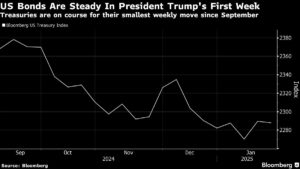Market Insights: Treasury Yields Take a Dip Amid Economic Signals
On Friday, U.S. Treasury yields experienced a welcome decline, contributing to a slight gain for the week as economic indicators began to show signs of cooling. This trend reflects a pivotal moment for investors keen on the future trajectory of interest rates and economic recovery.
Navigating Market Dynamics
Yields fell by at least two basis points across the board, with short-term maturities seeing a more pronounced drop of nearly four basis points. This movement came in response to unexpected data releases: S&P Global reported a decrease in its gauge of services activity, complemented by a downward revision of the University of Michigan’s sentiment index for January. As we witness this market rally, it’s essential to note that Treasury yields are concluding the week slightly lower.
The backdrop of these developments includes significant political movements, as the U.S. prepares for Donald Trump’s unprecedented second non-consecutive presidential term. The impact of such transitions on financial markets often leads to increased volatility and uncertainty, particularly in essential sectors like bonds.
Federal Reserve’s Next Move
Market participants eagerly await the next Federal Reserve meeting scheduled for January 28-29. Analysts uniformly anticipate that Fed Chair Jerome Powell and his colleagues will maintain the current target range for the overnight interest rate at 4.25%-4.5%. However, projections suggest a shift later in the year, with rate swaps indicating the possibility of two quarter-point cuts by year-end – a departure from the lone reduction previously expected just one week prior.
Keenly aware of the data-driven approach of the Federal Reserve, Christian Hoffmann, a portfolio manager at Thornburg Investment Management, noted the market’s hyper-focus on every economic release. The interplay of economic data and political developments will undoubtedly continue to create waves of volatility.
Inflation Concerns and Yield Reactions
The bond market previously faced a sell-off in September, culminating in 10-year Treasury yields reaching a 14-month high of 4.8%. This surge led to worries surrounding potential inflation stemming from trade protectionism. However, an influx of benign inflation data for December – reported on January 15 – along with comments from Fed Governor Christopher Waller suggesting a potential rate cut by mid-year, helped to stabilize the market.
The reaction of short-term Treasury yields, which are more sensitive to Federal Reserve intentions, has been noteworthy this week. The 10-year yield is currently 36 basis points above the two-year yield, an increase from the 34 basis point spread observed one week ago. This steepening yield curve indicates investors’ expectations of rising rates in the long term, reinforcing the importance of strategic asset allocation.
Final Thoughts
As we move through the year, monitoring economic indicators and Federal Reserve communications will be critical for investors in navigating the evolving landscape of U.S. Treasuries. The interplay of domestic policy, international trade, and macroeconomic data will undoubtedly shape our investment strategies moving forward.
Stay tuned with Extreme Investor Network, where we provide comprehensive insights and analyses tailored for savvy investors looking to maximize their financial potential.

